Opinion & Analysis
An early look at the potential U.S. Ryder Cup Team
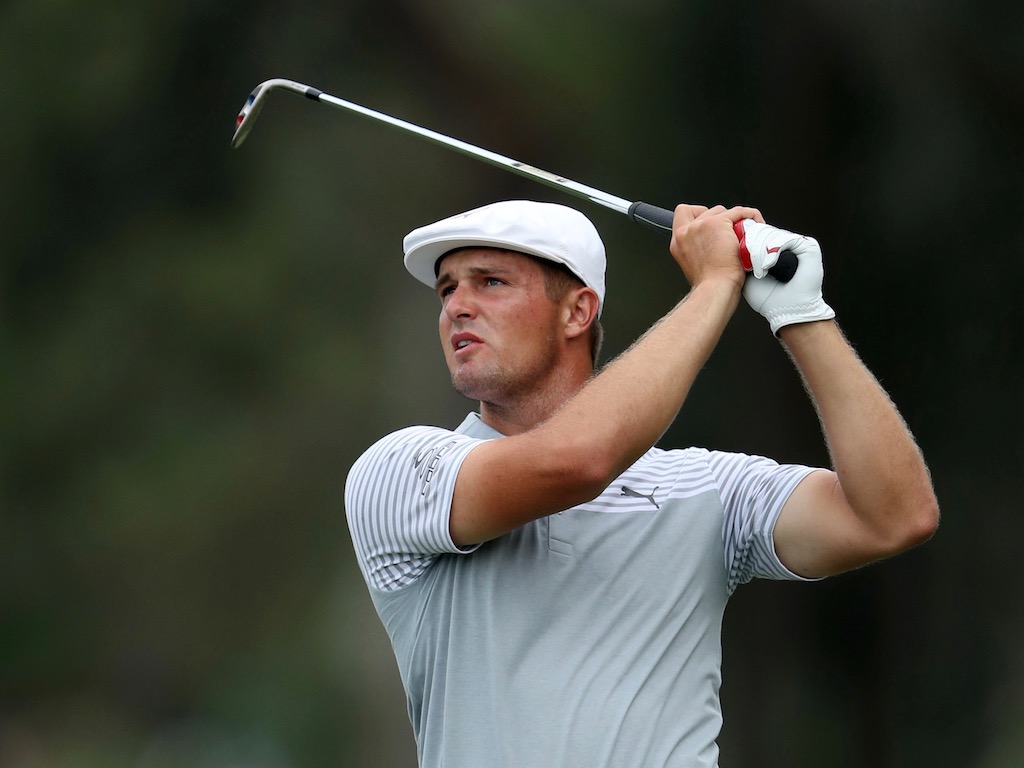
With the Masters and the Players Championship complete, I wanted to examine the statistics of the current leaders in Ryder Cup Points for the U.S. Team. Over the history of the Ryder Cup, the U.S. Team has relied on pairings that were friends and practice-round companions instead of pairing players that were more compatible from a statistical standpoint. This has led to disappointing performances from the U.S. Team and top players such as Jim Furyk performing poorly at the Ryder Cup, as he is ill-suited for the Fourball format.
After a disastrous 2014 Ryder Cup where the U.S. Team lost by a score of 16.5-11.5, the U.S. decided to use a more statistical approach to Ryder Cup play. According to my calculations, the 2016 U.S. Team’s pairings were the closest to optimal that the U.S. Team has compiled in the last seven Ryder Cups. And not surprisingly, the U.S. Team won 17-11 over the Europeans.
Since there are several months to go before the Ryder Cup, I won’t get too much into potential pairings in this article. Instead, I will focus more on the current games of top-12 players in U.S. Ryder Cup Points Standings and how that translates to Ryder Cup performance.
About the Ryder Cup Format
In the Ryder Cup, there is the Foursome format (alternate shot) and the Fourball format (best score). There are distinctly different metrics in the game that correlate to quality performers in each format.
In the Foursome format, short game around the green performance is usually critical. In a typical stroke play event such as The Players Championship, short game around the green performance usually has a much smaller impact on player’s performance. But in a match play, alternate-shot format the opposite has been true. My conclusion is that with the alternate-shot format, more greens in regulation are likely to be missed. The team that can save par and extend holes is usually likely to come out on top. The European team has mostly dominated the U.S. team over the past 20 years in the Foursome format, and the European teams typically are stronger with their short game around the green.
Other factors involved with Foursome play are Red Zone Performance (shots from 175-225 yards) and being able to pair the right players together based on how they each play off the tee and with their approach shots from the rough. For example, a pairing of Phil Mickelson (who misses a lot of fairways) and Zach Johnson (who is not very good from the rough) would likely be a poor pairing.
In the Fourball format (lowest score), the best performers are high birdie makers and players that perform well on the par-4s, par-5s, and par-3s. Bubba Watson makes a lot of birdies and plays the par-4s and par-5s well, thus making him a good candidate for the Fourball format. The only issue with Bubba in the past is he has occasionally struggled on the par-3s. That can be resolved by pairing him with a player who makes a lot of birdies and is a strong performer on the par-3s. The reason for Jim Furyk’s struggles in the Fourball format is that he does not make a lot of birdies and is a merely average performer on the par-5s.
Note: All rankings below are based out of 209 golfers.
1. Patrick Reed
In the past, it has been difficult to get an accurate depiction of Reed’s game. He was notorious for either getting into contention or blowing up if he wasn’t in contention after the first round. He is now far better at avoiding those blowup rounds and remaining competitive regardless of how he well he performs at the beginning of the tournament. His iron play has been excellent, and since he is good on approach shots from the rough, short game around the green and he makes a lot of birdies and plays the par-4s and par-5s well, he should continue to be a great competitor in the Ryder Cup format. Given his inability to find the fairway off the tee, however, I would recommend pairing him with a quality performer from the rough in the alternate shot format.
2. Justin Thomas
On paper, Thomas should be Team USA’s toughest competitor as he has little in the way of holes in his game. He drives it great, hits his irons well from every distance, has a superb short game and can putt. He also makes a ton of birdies, plays every type of hole well and rarely makes bogeys. Like Reed, it would be advisable to pair him with a player that is a quality performer from the rough in the alternate shot format.
3. Dustin Johnson
DJ is the second-strongest performer on paper. The only thing that currently separates Justin Thomas from DJ is their Red Zone play. DJ has typically been a world-class performer from the Red Zone, however, and the data suggests that his ranking from the Red Zone should rapidly improve. He struck it well from the Red Zone in his last two events at Harbour Town Golf Links and TPC Sawgrass. And with his putting performance this season, he could make for a great competitor in this year’s Ryder Cup.
4. Jordan Spieth
Spieth has the metrics to be a strong Ryder Cup performer, as he strikes the ball well with his driver and his irons while having a superb short game around the green. His only weakness in the Fourball format is his performance on the par-3s, but that is due to his inability to make putts from 15-25 feet (198th). That is the crux of the situation for Spieth; can he get his old putting form back?
A look at previous great putters on Tour that inexplicably struggled with their putter shows that Spieth is going about his putting woes the correct way. He’s not making equipment or wholesale changes to his putting stroke. He is continuing to work with what made him a great putter just like Jason Day did last year when he inexplicably struggled with the putter early in the season… and then turned it around and regained his old putting form.
The question is, how long will it take for Spieth to regain his old form? Typically, players like Spieth that have a dramatic drop-off in their putting take about a year to regain their old form. He may not regain that form by the time the Ryder Cup takes place. If he does, Team USA is very strong with its top-4 points earners.
5. Bubba Watson
Bubba is off to a strong enough year to make the U.S. Ryder Cup Team, but the best bet for him is to stick to the Fourball format given his struggles around the green. Watson’s performance on the par-5s has not exactly been remarkable, but typically he’s one of the very best in the world on par-5s and can make a ton of birdies.
6. Rickie Fowler
Fowler has not been as strong in some areas of the game such as Red Zone, shots from the rough and putting as he has been in recent years. That makes him a little less appealing in the alternate shot format, but he still has a solid foundation to be a quality contributor in either format. The upside is if Rickie gets back to his old form with the putter and from the Red Zone, he should be a top-notch Ryder Cup performer because he is well suited to perform in either team format. At this time, he would be best suited to play with an accurate driver and very good performer around the green (i.e. Matt Kuchar) in the alternate shot format.
7. Brooks Koepka
There currently is not enough data on Koepka due to his wrist injury he suffered early in the season. Koepka is arguably the best bomber in the world who is also a great putter and a solid performer from the Red Zone. The main issue for Koepka has been his short game performance around the green. That would typically make for a weak partner in the alternate shot format, but Koepka was spectacular in the 2016 Ryder Cup. His combination of length and putting may make him a formidable Ryder Cup performer for years to come.
8. Phil Mickelson
As a statistical analyst for golf, I never quite know what I’m going to get from Lefty. This season Lefty has putted superbly, but his performance around the green has left a lot to be desired.
In recent Ryder Cups, he has been a quality performer in both the Foursome and Fourball formats. His recent success in the alternate shot format makes him a mandatory candidate, however, his inability to find the fairway means he would need a partner who is very good from the rough. The data suggests that his performance around the green should get closer to his old form as the season goes along.
9. Webb Simpson
Like Mickelson, it’s always a surprise as to what the strengths and weaknesses of Simpson’s game will be by the end of the season. Typically, he’s been a decent driver of the ball that is often a superb iron player and short game performer. With the anchoring ban, he has struggled with the putter up to this season. Lately, he has been an incredible putter that is struggling a bit with the irons.
Most of Simpson’s struggles with the irons have been from the rough, so a partner who finds a lot of fairways off the tee could be an excellent pairing in the foursome format with Simpson.
10. Matt Kuchar
Kuchar could be a very critical player for Team USA down the stretch. There are potential players on the team that could be valuable in the alternate shot format if they can find a teammate to find fairways off the tee to make up for their struggles on approach shots from the rough. Historically, Kuchar has been the most accurate off the tee of the players mentioned thus far.
This season, however, Kuchar has been underwhelming in his ability to find the fairway. The next most-accurate drivers of the ball that are near the top-12 in Ryder Cup points are Brian Harman, Bryson DeChambeau, Kevin Kisner and Andrew Landry, and none of them have nearly the experience in the Ryder Cup as Kuchar has. If Kuchar continues to miss fairways, his chances of making the team are not good unless he’s a Captain’s pick. If he cannot find the fairway, he has little-projected value as a member of the team. He is not making a lot of birdies, and his struggles on the par-3s and does not make him a favorable teammate in the Fourball format either.
11. Brian Harman
Harman’s value is that he has fairly decent Fourball metrics and his accuracy off the tee, putting, and iron play can work well with players like Fowler, Simpson, and Kuchar in the alternate shot format.
Harman has not performed that well from around the green using the Strokes Gained methodology, however; he ranks 15th on shots from 10-20 yards. I placed that metric in there as strokes gained takes into account all shots from less than 30 yards, but 10-20 yards is the most common distance range from which scrambling opportunities occur on Tour. Thus, Harman is an excellent performer from 10-20 yards and is only losing strokes around the green due to poor performance from 20-30 yards, and those shots occur less frequently on Tour. His struggles from 20-30 yards would also explain why his par-5 performance is roughly average, as that is the distance players typically finish from the hole when they go for par-5s in two and do not make the green.
And even though Harman is not very long off the tee (147th in Measured Driving Distance), he is a quality performer from the rough and thus he does not have to be tethered to another short-hitting, accurate driver in the alternate shot format.
12. Bryson DeChambeau
Dechambeau makes for a solid Ryder Cup candidate, as he has no outstanding weaknesses in his game this season as he appears to have rid himself of the putting woes that have hurt him in the past. I think he is better suited for the Fourball format, however, given how many birdies he makes. Pair him with a strong performer on the par-3s like Rickie Fowler or Phil Mickelson and it would make a very formidable duo in that format.
A pairing with Mickelson in the Fourball format would be intriguing given DeChambeau’s excellent driving. DeChambeau could hit first and — if he continues to drive it superbly — that would free up Mickelson to not worry so much about his woeful driving and focus more on making birdies. Perhaps a Fourball pairing with Bubba would make for a situation where DeChambeau could tee off first and pipe his drive, and then give Bubba a free rip to hit it as far as he possibly can and give them a sizeable advantage over their opponents.
31. Tiger Woods
I know I said I was only going to look at the top-12 players in Ryder Cup points, but the readers would inevitably ask about Tiger anyway. Furthermore, Tiger is an intriguing candidate for the team given his current game.
Tiger has struggled in both the Foursome and Fourball format. He seems to not play that great in alternate shot. In Fourball, it appears that he plays well by himself, but he is often let down by his teammates. The Europeans have always gunned for Tiger in the Ryder Cup, and it takes a special type of teammate to deal with the hysteria of having Tiger as their partner.
There are the makings of a very good alternate shot partner with Tiger, as his iron play and putting are still really good and his short game has been incredible this season. In the Fourball format, it would be advisable to find a strong par-5 performer, as Tiger’s performance on the par-5s has not been outstanding thus far. Having said that, I could see three excellent partners for Tiger in either format.
Patrick Reed has the numbers to be compatible with Tiger’s game, and he also has the track record of living up to the moment in the Ryder Cup. Dustin Johnson is can make up for Tiger’s possible big misses off the tee and can overpower a course with Tiger. And Phil Mickelson, whose game is compatible with Tiger’s, and could provide a symbol of the old guard working together to beat the Europeans.
There are certainly a lot of compelling possible pairings for Team USA, and there is still a long way to go before we start to see what pairings are available. The European Team looks like one of the strongest in years, and with all of the potential storylines for the 2018 Ryder Cup, it could be one of the greatest Ryder Cups of all time.
- LIKE59
- LEGIT4
- WOW6
- LOL1
- IDHT1
- FLOP1
- OB1
- SHANK9
19th Hole
Vincenzi’s LIV Golf Singapore betting preview: Course specialist ready to thrive once again

After another strong showing in Australia, LIV Golf will head to Sentosa Golf Club in Singapore looking to build off of what was undoubtedly their best event to date.
Sentosa Golf Club sits on the southern tip of Singapore and is one of the most beautiful courses in the world. The course is more than just incredible scenically; it was also rated 55th in Golf Digest’s top-100 courses in 2022-2023 and has been consistently regarded as one of the best courses in Asia. Prior to being part of the LIV rotation, the course hosted the Singapore Open every year since 2005.
Sentosa Golf Club is a par 71 measuring 7,406 yards. The course will require precise ball striking and some length off the tee. It’s possible to go low due to the pristine conditions, but there are also plenty of hazards and difficult spots on the course that can bring double bogey into play in a hurry. The Bermudagrass greens are perfectly manicured, and the course has spent millions on the sub-air system to keep the greens rolling fast. I spoke to Asian Tour player, Travis Smyth, who described the greens as “the best [he’s] ever played.”
Davis Love III, who competed in a Singapore Open in 2019, also gushed over the condition of the golf course.
“I love the greens. They are fabulous,” the 21-time PGA Tour winner said.
Love III also spoke about other aspects of the golf course.
“The greens are great; the fairways are perfect. It is a wonderful course, and it’s tricky off the tee.”
“It’s a long golf course, and you get some long iron shots. It takes somebody hitting it great to hit every green even though they are big.”
As Love III said, the course can be difficult off the tee due to the length of the course and the trouble looming around every corner. It will take a terrific ball striking week to win at Sentosa Golf Club.
In his pre-tournament press conference last season, Phil Mickelson echoed many of the same sentiments.
“To play Sentosa effectively, you’re going to have a lot of shots from 160 to 210, a lot of full 6-, 7-, 8-iron shots, and you need to hit those really well and you need to drive the ball well.”
Golfers who excel from tee to green and can dial in their longer irons will have a massive advantage this week.
Stat Leaders at LIV Golf Adelaide:
Fairways Hit
1.) Louis Oosthuizen
2.) Anirban Lahiri
3.) Jon Rahm
4.) Brendan Steele
5.) Cameron Tringale
Greens in Regulation
1.) Brooks Koepka
2.) Brendan Steele
3.) Dean Burmester
4.) Cameron Tringale
5.) Anirban Lahiri
Birdies Made
1.) Brendan Steele
2.) Dean Burmester
3.) Thomas Pieters
4.) Patrick Reed
5.) Carlos Ortiz
LIV Golf Individual Standings:
1.) Joaquin Niemann
2.) Jon Rahm
3.) Dean Burmester
4.) Louis Oosthuizen
5.) Abraham Ancer
LIV Golf Team Standings:
1.) Crushers
2.) Legion XIII
3.) Torque
4.) Stinger GC
5.) Ripper GC
LIV Golf Singapore Picks
Sergio Garcia +3000 (DraftKings)
Sergio Garcia is no stranger to Sentosa Golf Club. The Spaniard won the Singapore Open in 2018 by five strokes and lost in a playoff at LIV Singapore last year to scorching hot Talor Gooch. Looking at the course setup, it’s no surprise that a player like Sergio has played incredible golf here. He’s long off the tee and is one of the better long iron players in the world when he’s in form. Garcia is also statistically a much better putter on Bermudagrass than he is on other putting surfaces. He’s putt extremely well on Sentosa’s incredibly pure green complexes.
This season, Garcia has two runner-up finishes, both of them being playoff losses. Both El Camaleon and Doral are courses he’s had success at in his career. The Spaniard is a player who plays well at his tracks, and Sentosa is one of them. I believe Sergio will get himself in the mix this week. Hopefully the third time is a charm in Singapore.
Paul Casey +3300 (FanDuel)
Paul Casey is in the midst of one of his best seasons in the five years or so. The results recently have been up and down, but he’s shown that when he’s on a golf course that suits his game, he’s amongst the contenders.
This season, Casey has finishes of T5 (LIV Las Vegas), T2 (LIV Hong Kong), and a 6th at the Singapore Classic on the DP World Tour. At his best, the Englishman is one of the best long iron players in the world, which makes him a strong fit for Sentosa. Despite being in poor form last season, he was able to fire a Sunday 63, which shows he can low here at the course.
It’s been three years since Casey has won a tournament (Omega Dubai Desert Classic in 2021), but he’s been one of the top players on LIV this season and I think he can get it done at some point this season.
Mito Pereira +5000 (Bet365)
Since Mito Pereira’s unfortunate demise at the 2022 PGA Championship, he’s been extremely inconsistent. However, over the past few months, the Chilean has played well on the International Series as well as his most recent LIV start. Mito finished 8th at LIV Adelaide, which was his best LIV finish this season.
Last year, Pereira finished 5th at LIV Singapore, shooting fantastic rounds of 67-66-66. It makes sense why Mito would like Sentosa, as preeminent ball strikers tend to rise to the challenge of the golf course. He’s a great long iron player who is long and straight off the tee.
Mito has some experience playing in Asia and is one of the most talented players on LIV who’s yet to get in the winner’s circle. I have questions about whether or not he can come through once in contention, but if he gets there, I’m happy to roll the dice.
Andy Ogletree +15000 (DraftKings)
Andy Ogletree is a player I expected to have a strong 2024 but struggled early in his first full season on LIV. After failing to crack the top-25 in any LIV event this year, the former U.S. Amateur champion finally figured things out, finished in a tie for 3rd at LIV Adelaide.
Ogletree should be incredible comfortable playing in Singapore. He won the International Series Qatar last year and finished T3 at the International Series Singapore. The 26-year-old was arguably the best player on the Asian Tour in 2023 and has been fantastic in the continent over the past 18 months.
If Ogletree has indeed found form, he looks to be an amazing value at triple-digit odds.
- LIKE3
- LEGIT3
- WOW1
- LOL2
- IDHT0
- FLOP2
- OB0
- SHANK0
Opinion & Analysis
Ryan: Lessons from the worst golf instructor in America

In Tampa, there is a golf course that boasts carts that do not work, a water range, and a group of players none of which have any chance to break 80. The course is overseen by a staff of crusty men who have succeeded at nothing in life but ending up at the worst-run course in America. However, this place is no failure. With several other local courses going out of business — and boasting outstanding greens — the place is booked full.
While I came for the great greens, I stayed to watch our resident instructor; a poor-tempered, method teacher who caters to the hopeless. At first, it was simply hilarious. However, after months of listening and watching, something clicked. I realized I had a front-row seat to the worst golf instructor in America.
Here are some of my key takeaways.
Method Teacher
It is widely accepted that there are three types of golf instructors: system teachers, non-system teachers, and method teachers. Method teachers prescribe the same antidote for each student based on a preamble which teachers can learn in a couple day certification.
Method teaching allows anyone to be certified. This process caters to the lowest caliber instructor, creating the illusion of competency. This empowers these underqualified instructors with the moniker of “certified” to prey on the innocent and uninformed.
The Cult of Stack and Jilt
The Stack and Tilt website proudly boasts, “A golfer swings his hands inward in the backswing as opposed to straight back to 1) create power, similar to a field goal kicker moving his leg in an arc and 2) to promote a swing that is in-to-out, which produces a draw (and eliminates a slice).”
Now, let me tell you something, there is this law of the universe which says “energy can either be created or destroyed,” so either these guys are defying physics or they have no idea what they are taking about. Further, the idea that the first move of the backswing determines impact is conjecture with a splash of utter fantasy.
These are the pontifications of a method — a set of prescriptions applied to everyone with the hope of some success through the placebo effect. It is one thing for a naive student to believe, for a golf instructor to drink and then dispel this Kool-Aid is malpractice.
Fooled by Randomness
In flipping a coin, or even a March Madness bet, there is a 50-50 chance of success. In golf, especially for new players, results are asymmetric. Simply put: Anything can happen. The problem is that when bad instructors work with high handicappers, each and every shot gets its own diagnosis and prescription. Soon the student is overwhelmed.
Now here’s the sinister thing: The overwhelming information is by design. In this case, the coach is not trying to make you better, they are trying to make you reliant on them for information. A quasi Stockholm syndrome of codependency.
Practice
One of the most important scientists of the 20th century was Ivan Pavlov. As you might recall, he found that animals, including humans, could be conditioned into biological responses. In golf, the idea of practice has made millions of hackers salivate that they are one lesson or practice session from “the secret.”
Sunk Cost
The idea for the worst golf instructor is to create control and dependency so that clients ignore the sunk cost of not getting better. Instead, they are held hostage by the idea that they are one lesson or tip away from unlocking their potential.
Cliches
Cliches have the effect of terminating thoughts. However, they are the weapon of choice for this instructor. Add some hyperbole and students actually get no information. As a result, these players couldn’t play golf. When they did, they had no real scheme. With no idea what they are doing, they would descend into a spiral of no idea what to do, bad results, lower confidence, and running back to the lesson tee from more cliches.
The fact is that poor instruction is about conditioning players to become reliant members of your cult. To take away autonomy. To use practice as a form of control. To sell more golf lessons not by making people better but through the guise that without the teacher, the student can never reach their full potential. All under the umbrella of being “certified” (in a 2-day course!) and a melee of cliches.
This of course is not just happening at my muni but is a systemic problem around the country and around the world, the consequences of which are giving people a great reason to stop playing golf. But hey, at least it’s selling a lot of golf balls…
- LIKE17
- LEGIT2
- WOW0
- LOL4
- IDHT1
- FLOP1
- OB0
- SHANK19
19th Hole
Vincenzi’s 2024 Zurich Classic of New Orleans betting preview

The PGA TOUR heads to New Orleans to play the 2023 Zurich Classic of New Orleans. In a welcome change from the usual stroke play, the Zurich Classic is a team event. On Thursday and Saturday, the teams play best ball, and on Friday and Sunday the teams play alternate shot.
TPC Louisiana is a par 72 that measures 7,425 yards. The course features some short par 4s and plenty of water and bunkers, which makes for a lot of exciting risk/reward scenarios for competitors. Pete Dye designed the course in 2004 specifically for the Zurich Classic, although the event didn’t make its debut until 2007 because of Hurricane Katrina.
Coming off of the Masters and a signature event in consecutive weeks, the field this week is a step down, and understandably so. Many of the world’s top players will be using this time to rest after a busy stretch.
However, there are some interesting teams this season with some stars making surprise appearances in the team event. Some notable teams include Patrick Cantlay and Xander Schauffele, Rory McIlroy and Shane Lowry, Collin Morikawa and Kurt Kitayama, Will Zalatoris and Sahith Theegala as well as a few Canadian teams, Nick Taylor and Adam Hadwin and Taylor Pendrith and Corey Conners.
Past Winners at TPC Louisiana
- 2023: Riley/Hardy (-30)
- 2022: Cantlay/Schauffele (-29)
- 2021: Leishman/Smith (-20)
- 2019: Palmer/Rahm (-26)
- 2018: Horschel/Piercy (-22)
- 2017: Blixt/Smith (-27)
2024 Zurich Classic of New Orleans Picks
Tom Hoge/Maverick McNealy +2500 (DraftKings)
Tom Hoge is coming off of a solid T18 finish at the RBC Heritage and finished T13 at last year’s Zurich Classic alongside Harris English.
This season, Hoge is having one of his best years on Tour in terms of Strokes Gained: Approach. In his last 24 rounds, the only player to top him on the category is Scottie Scheffler. Hoge has been solid on Pete Dye designs, ranking 28th in the field over his past 36 rounds.
McNealy is also having a solid season. He’s finished T6 at the Waste Management Phoenix Open and T9 at the PLAYERS Championship. He recently started working with world renowned swing coach, Butch Harmon, and its seemingly paid dividends in 2024.
Keith Mitchell/Joel Dahmen +4000 (DraftKings)
Keith Mitchell is having a fantastic season, finishing in the top-20 of five of his past seven starts on Tour. Most recently, Mitchell finished T14 at the Valero Texas Open and gained a whopping 6.0 strokes off the tee. He finished 6th at last year’s Zurich Classic.
Joel Dahmen is having a resurgent year and has been dialed in with his irons. He also has a T11 finish at the PLAYERS Championship at TPC Sawgrass which is another Pete Dye track. With Mitchell’s length and Dahmen’s ability to put it close with his short irons, the Mitchell/Dahmen combination will be dangerous this week.
Taylor Moore/Matt NeSmith +6500 (DraftKings)
Taylor Moore has quickly developed into one of the more consistent players on Tour. He’s finished in the top-20 in three of his past four starts, including a very impressive showing at The Masters, finishing T20. He’s also finished T4 at this event in consecutive seasons alongside Matt NeSmith.
NeSmith isn’t having a great 2024, but has seemed to elevate his game in this format. He finished T26 at Pete Dye’s TPC Sawgrass, which gives the 30-year-old something to build off of. NeSmith is also a great putter on Bermudagrass, which could help elevate Moore’s ball striking prowess.
- LIKE8
- LEGIT3
- WOW1
- LOL1
- IDHT0
- FLOP3
- OB1
- SHANK2
-

 19th Hole2 weeks ago
19th Hole2 weeks agoJustin Thomas on the equipment choice of Scottie Scheffler that he thinks is ‘weird’
-

 19th Hole2 weeks ago
19th Hole2 weeks ago‘Absolutely crazy’ – Major champ lays into Patrick Cantlay over his decision on final hole of RBC Heritage
-

 19th Hole3 weeks ago
19th Hole3 weeks agoTwo star names reportedly blanked Jon Rahm all week at the Masters
-

 19th Hole3 weeks ago
19th Hole3 weeks agoReport: LIV Golf identifies latest star name they hope to sign to breakaway tour
-

 19th Hole3 weeks ago
19th Hole3 weeks agoNeal Shipley presser ends in awkward fashion after reporter claims Tiger handed him note on 8th fairway
-

 19th Hole2 weeks ago
19th Hole2 weeks agoBrandel Chamblee has ‘no doubt’ who started the McIlroy/LIV rumor and why
-

 19th Hole1 week ago
19th Hole1 week agoLET pro gives detailed financial breakdown of first week on tour…and the net result may shock you
-

 Equipment2 weeks ago
Equipment2 weeks agoJason Day on his recent switch into Srixon ZX5 and ZX7 Mk II irons

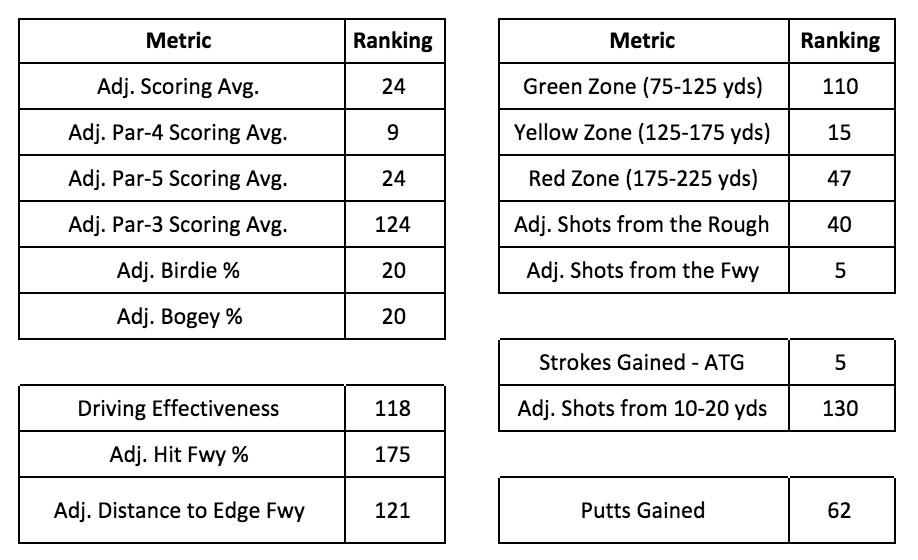
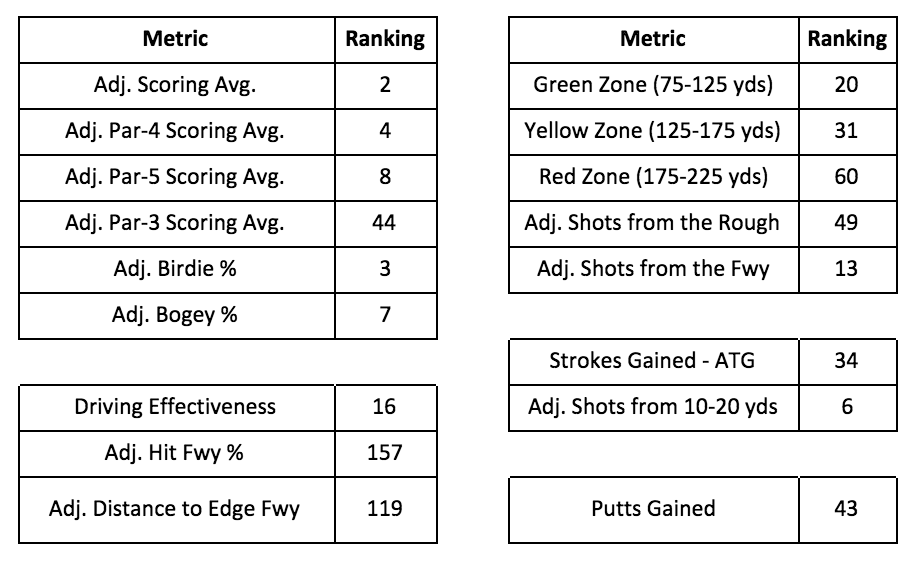
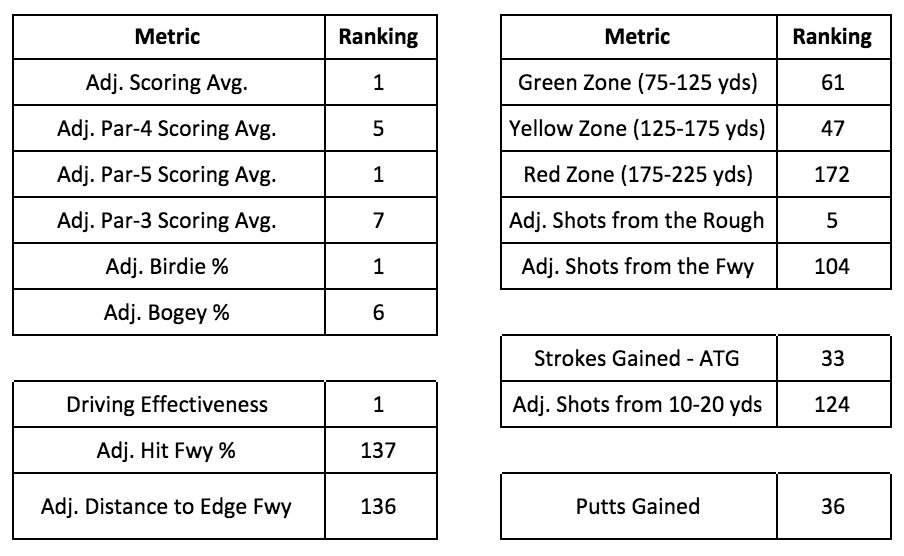
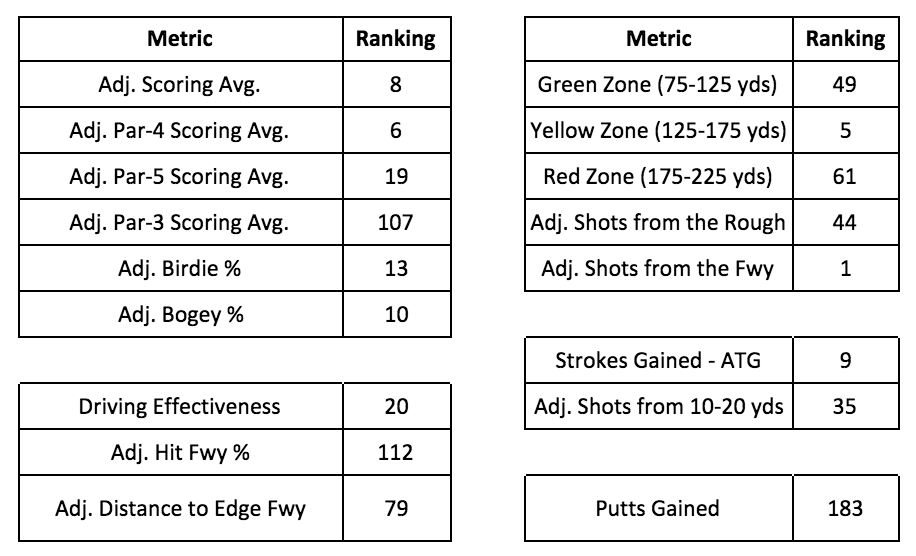
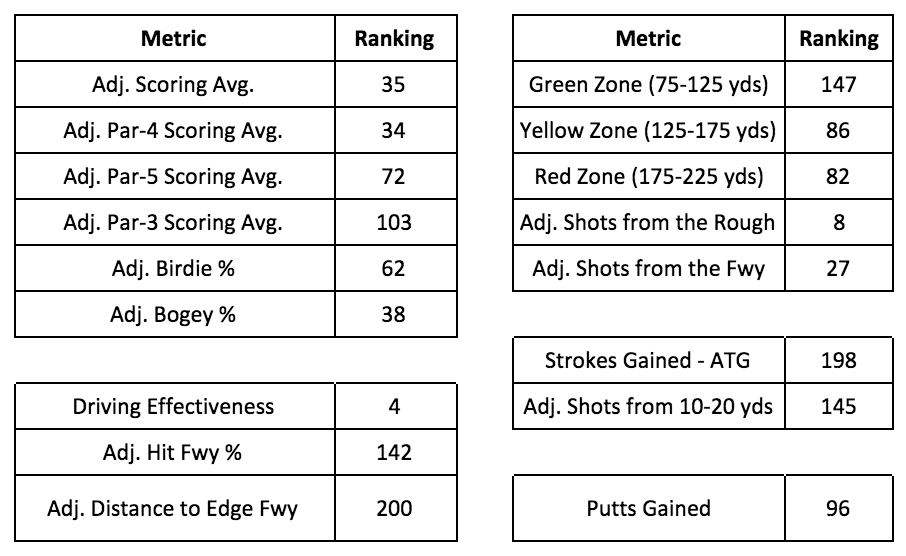

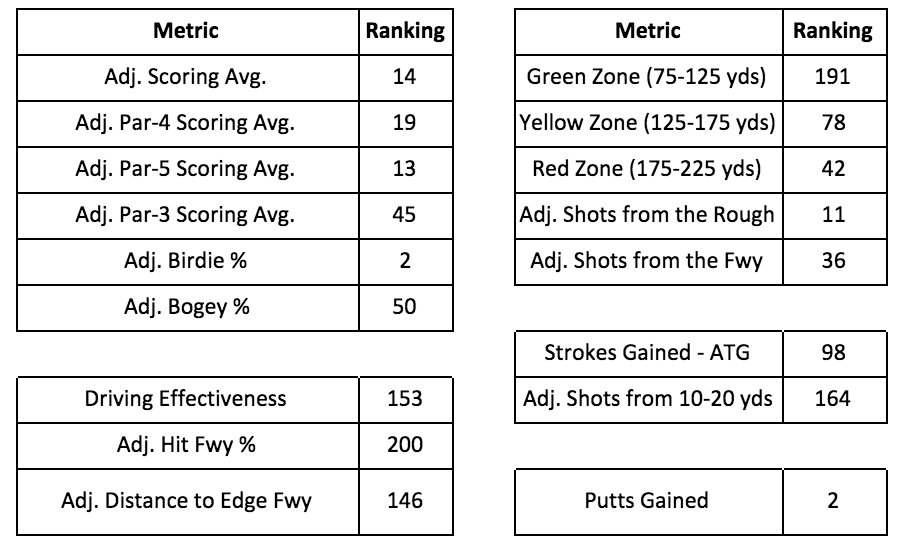


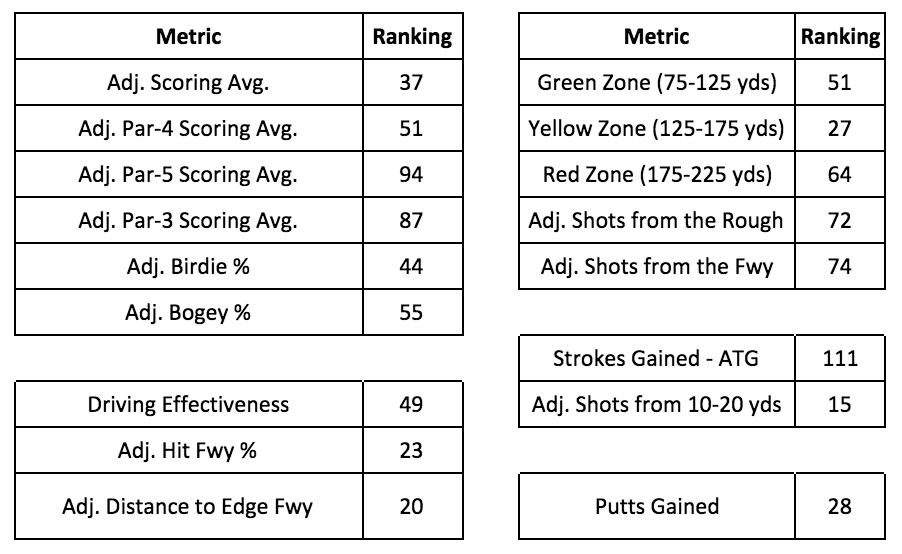
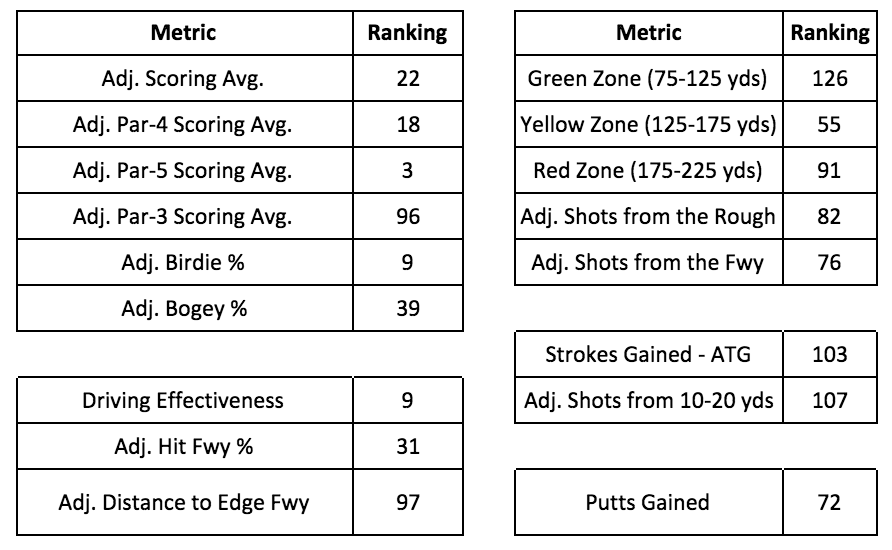
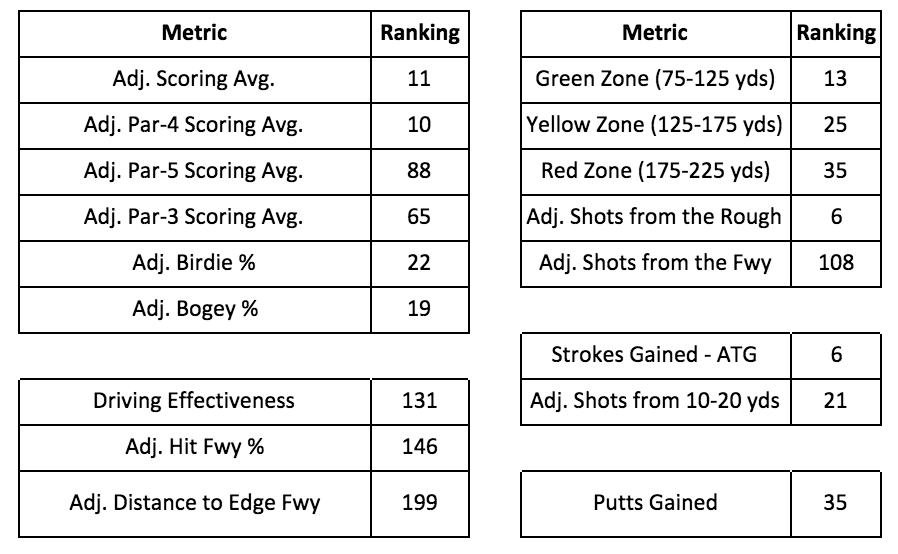

























2putttom
May 24, 2018 at 1:37 pm
we need a rookie / 2nd yr. player on there.
ogo
May 24, 2018 at 12:16 pm
Aaaaah … the U.S. Tribal Ryder Cup Tribal Team ….. 😮
Tyler
May 24, 2018 at 2:43 pm
It couldn’t get any worse than Tom Watson’s picks. I lost a lot of respect for him over those.
moses
May 24, 2018 at 11:32 am
Hopefully Tiger continues his good play to become a Captain’s pick.
ogo
May 24, 2018 at 12:17 pm
…. as long as he doesn’t kneel during the playing of the national anthem … 😛
3PuttPar
May 24, 2018 at 10:20 am
“In the Fourball format (lowest score), the best performers are high birdie makers and players that perform well on the par-4s, par-5s, and par-3s.”
Sooo players that perform well on all holes? What other holes are left? LOL
James Glenn
May 24, 2018 at 10:05 am
Rich, love the work — but doubt you need to include the metric of “performing well on par-4s, par-5s, and par-3s.” That covers every hole in golf, so essentially we want players who perform well on every hole? Otherwise, love it.
Rich Hunt
May 24, 2018 at 2:44 pm
I will give an example of what I mean by it.
Typically, Bubba Watson dominates the par-4’s and par-5’s. On Tour, par-4 performance is the most important of the holes with regards to its correlation to success on Tour. The reason why is that the average Tour player plays 10-11 par-4’s per round. Despite dominating the par-4’s and par-5’s, Bubba tends to struggle on the par-3’s over his career. He will still be one of the very top players in the US, but having him in the Fourball format can create a glaring deficiency on the par-3’s if he’s not paired with a good par-3 performer.
Other players may not quite dominate the par-4’s and par-5’s like Bubba does. But, if they are sound performers on the par-4’s, par-5’s and par-3’s and make quite a few birdies…then they may very well be better suited for the Fourball format over Bubba.